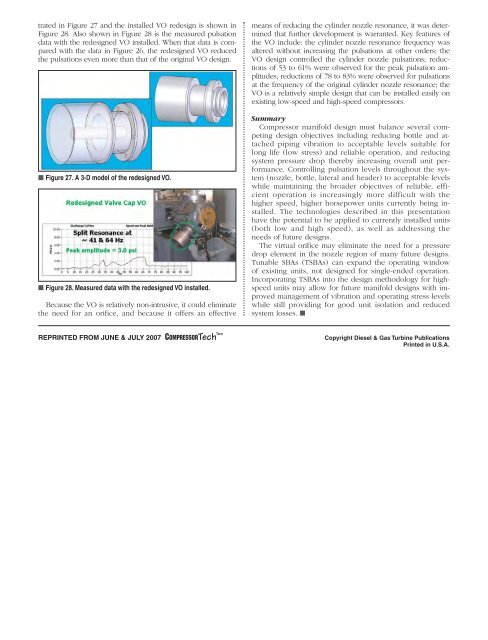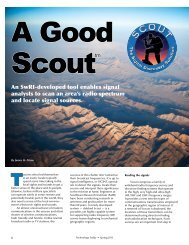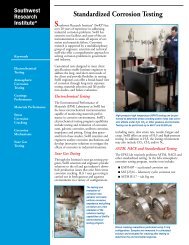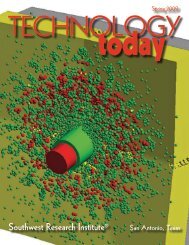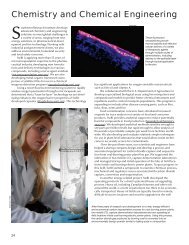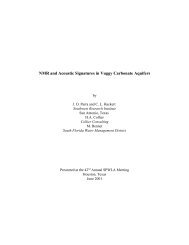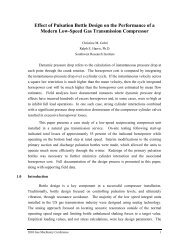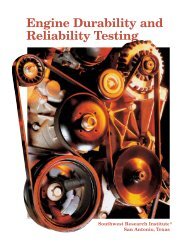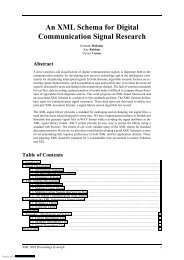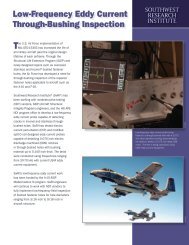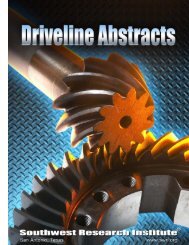gmrc advanced reciprocating compressor technology - Southwest ...
gmrc advanced reciprocating compressor technology - Southwest ...
gmrc advanced reciprocating compressor technology - Southwest ...
You also want an ePaper? Increase the reach of your titles
YUMPU automatically turns print PDFs into web optimized ePapers that Google loves.
trated in Figure 27 and the installed VO redesign is shown in<br />
Figure 28. Also shown in Figure 28 is the measured pulsation<br />
data with the redesigned VO installed. When that data is compared<br />
with the data in Figure 26, the redesigned VO reduced<br />
the pulsations even more than that of the original VO design.<br />
■ Figure 27. A 3-D model of the redesigned VO.<br />
■ Figure 28. Measured data with the redesigned VO installed.<br />
Because the VO is relatively non-intrusive, it could eliminate<br />
the need for an orifice, and because it offers an effective<br />
means of reducing the cylinder nozzle resonance, it was determined<br />
that further development is warranted. Key features of<br />
the VO include: the cylinder nozzle resonance frequency was<br />
altered without increasing the pulsations at other orders; the<br />
VO design controlled the cylinder nozzle pulsations; reductions<br />
of 53 to 61% were observed for the peak pulsation amplitudes;<br />
reductions of 78 to 83% were observed for pulsations<br />
at the frequency of the original cylinder nozzle resonance; the<br />
VO is a relatively simple design that can be installed easily on<br />
existing low-speed and high-speed <strong>compressor</strong>s.<br />
Summary<br />
Compressor manifold design must balance several competing<br />
design objectives including reducing bottle and attached<br />
piping vibration to acceptable levels suitable for<br />
long life (low stress) and reliable operation, and reducing<br />
system pressure drop thereby increasing overall unit performance.<br />
Controlling pulsation levels throughout the system<br />
(nozzle, bottle, lateral and header) to acceptable levels<br />
while maintaining the broader objectives of reliable, efficient<br />
operation is increasingly more difficult with the<br />
higher speed, higher horsepower units currently being installed.<br />
The technologies described in this presentation<br />
have the potential to be applied to currently installed units<br />
(both low and high speed), as well as addressing the<br />
needs of future designs.<br />
The virtual orifice may eliminate the need for a pressure<br />
drop element in the nozzle region of many future designs.<br />
Tunable SBAs (TSBAs) can expand the operating window<br />
of existing units, not designed for single-ended operation.<br />
Incorporating TSBAs into the design methodology for highspeed<br />
units may allow for future manifold designs with improved<br />
management of vibration and operating stress levels<br />
while still providing for good unit isolation and reduced<br />
system losses. ■<br />
REPRINTED FROM JUNE & JULY 2007 COMPRESSORTech Two<br />
Copyright Diesel & Gas Turbine Publications<br />
Printed in U.S.A.


